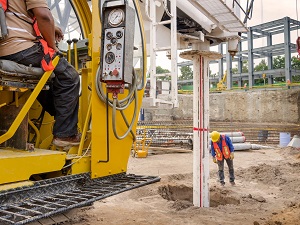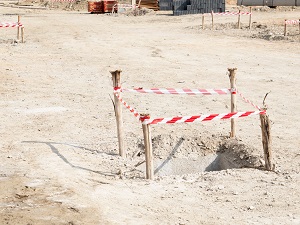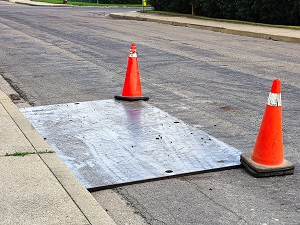Floor holes are frequently present on construction sites. They can be found inside of buildings, on rooftops or roadways, and throughout outdoor jobsites. A floor hole presents trip or fall hazards to workers and can lead to serious injuries or fatalities.

OSHA considers FALLS a serious hazard that are the cause for most of the fatalities in the construction industry.
Floor holes must never be ignored! Always look for areas that may have floor holes and be aware of situations where holes may not be adequately marked, covered, barricaded, or guarded.
OSHA Standard 1926.500(b) defines a hole as a gap or void 2 inches (5.1 cm) or more in its least dimension, in a floor, roof, or other walking/working surface.
OSHA considers any gap larger than 2 inches wide on any walking/working surface as a floor hole. Even holes, cracks or depressions in the ground that are as small as 2 inches wide can still pose a serious tripping hazard.

Walking/working surfaces can be horizontal or vertical and may include floors, roofs, ramps, bridges, concrete reinforcing steel or any surface on which an employee walks or works to perform their job duties.
OSHA categorizes floor holes into two main types:
- Holes more than 6 feet deep that a person can fall into that require protection by fall arrest systems, guardrails or covers.
- Holes less than 6 feet deep (no minimum depth specified) that require employees to be protected from tripping or stepping into the holes by placing covers over them.
Examples of floor holes include:
- Missing Floor Boards
- Sunken Gravel or Dirt
- Fully Enclosed Ladder
- Roof and Floor Drains
- Chipped or Broken Concrete
- Precast Concrete Openings
- Elevator Shafts
- Drilled Pier Holes
- Manholes
- Skylights

When a hole is not in use, always ensure it is protected by a cover or a guardrail system that is added along all unprotected sides of the hole.
Floor holes or openings must be protected to prevent workers from tripping and/or falling into them.
OSHA Standard 1926.501(b)(4)(ii) Each employee on a walking/working surface shall be protected from tripping in or stepping into or through holes by covers.
The floor hole cover should be strong and durable enough to withstand at least twice the weight of employees, equipment and materials that may be imposed on the cover at anytime.
If protective covers are not installed or available for floor holes noticed on the job site, immediately notify appropriate personnel to address the hazard.
Skylights must have fall arrest systems, guardrails or covers to prevent falls to lower levels.
Do not work near skylights unless adequate fall protection is in place.
OSHA Standard 1926.501(b)(4)(iii) Each employee on a walking/working surface shall be protected from objects falling through holes (including skylights) by covers.
Open floor holes, including skylights, or floor holes with inadequate protection, may create a struck-by hazard to another person who may be walking or working below the floor hole.

Floor hole covers should be installed or secured in a way to prevent accidental displacement by the wind, equipment or other employees.
OSHA Standard 1926.502(i)(1) Covers [for floor holes] located in roadways and vehicular aisles shall be capable of supporting, without failure, at least twice the maximum axle load of the largest vehicle expected to cross over the cover.
Never use paper, cardboard, a tarp, or other soft material to cover a floor hole.
Guard all new floor holes immediately.
Always use a personal fall arrest system (PFAS) when it is required to work near or over any uncovered opening more than 6-feet above a lower level.


.jpg)


.jpg)